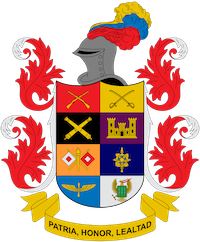Geopolitics of the crisis in Ukraine
Abstract
This article is the result of research in the context of the Observatory of Geopolitics and International Security of the School of International Relations of the Military Cadet School "General José María Córdova", whose objective is to generate a permanent analysis of the international reality from geographical and historical frameworks that allow understanding the dynamics of competition and conflict in the international system. The reader will find an analysis of the crisis in Ukraine from a neorealist perspective, with elements of neoclassical geopolitics, emphasizing historical, strategic, national security and military issues, in a re-edition of the classical paradigms of international relations.
Thus, the article is composed of a detailed description of the internal political situation in Ukraine that led to the protests known as Euromaidan, the subsequent secessionism and the civil war, in which the historical idea of Novorossiya (New Russia) is determinant to understand Moscow's interventionism in the crisis. Subsequently, the geopolitics of Ukraine and the Black Sea are analyzed and special emphasis is placed on the geoeconomics of gas and its location as a point of confluence of three great civilizations, namely Western, Russian-Orthodox and Turkish-Ottoman. Next, the reader will find the main arguments that differentiate the current strategic competition between Russia and the West in the face of the Cold War, emphasizing that Vladimir Putin's geopolitical logic resembles more that of the former Tsarist empire than that of the Soviet Union.
Finally, it analyzes the probabilities of a military escalation of the crisis, identifies possible Russian courses of action and the need for a NATO response in terms of deterrence, which leads to highlighting the fact that the Mutually Assured Deterrence of nuclear weapons remains a fact of life in the international system.
Downloads
References
Basora, A. (2014). Putin’s greater Novorossiya: the dismemberment of Ukraine? E-Notes, Foreign Policy Research Institute. Philadelphia, EU. Recuperado de: http://www.isn.ethz.ch/Digital-Library/Publications/Detail/?fecvnodeid=127055&dom=1&groupot593=26b029ba-8af6-464b-898a-d16dd7d15a02&ots591=0c54e3b3-1e9c-be1e-2c24-a6a8c7060233&lng=en&ots627=0c54e3b3-1e9c-be1e-2c24-a6a8c7060233&fecvid=21&v21=127055&id=179992.
Bassets, L. (23 de marzo, 2014). Quiebro estratégico. El País. Madrid, España. Recuperado de: http://elpais.com/elpais/2014/03/21/opinion/1395398943_826299.html.
Cecire, M. (2014). The Georgian Defense. Foreign Policy. Recuperado de: http://www.foreignpolicy.com/articles/2014/03/11/the_georgian_defense.
Chen, D. (2014). Are China and Russia moving toward a formal alliance? The Diplomat Review. Recuperado de: http://thediplomat.com/2014/05/are-china-and-russia-moving-toward-a-formal-alliance/.
Davidson, J. (2014). Thinking the unthinkable in Ukraine. The National Interest. Recuperado de: http://nationalinterest.org/commentary/thinking-the-unthinkable-ukraine-10090.
DW. (2014). ¿Is nato expansion to blame for Crimea crisis? Recuperado de: http://www.dw.de/is-nato-expansion-to-blame-for-crimean-crisis/a-17527361, consultado el 18 de abril de 2014.
Escribano, G. (2014a). Gas ruso para ucrania: ¿natural o lacrimógeno? Madrid, España: Real Instituto Elcano No. 13. Comentario. Recuperado de: http://www.realinstitutoelcano.org/wps/portal/web/rielcano_es/contenido?WCM_GLOBAL_CONTEXT=/elcano/elcano_es/zonas_es/comentario-escribano-gas-ruso-ucrania-natural-lacrimogeno#.U1Pzbfl5N5d.
Escribano, G. (2014b). Las consecuencias energéticas del conflicto de Ucrania. Madrid, España: Real Instituto Elcano. Documento de Opinión. Recuperado de: http://www.realinstitutoelcano.org/wps/portal/web/rielcano_es/contenido?WCM_GLOBAL_CONTEXT=/elcano/elcano_es/zonas_es/escribano-consecuencias-energeticas-del-conflicto-de-ucrania#.U1PzZvl5N5d.
Felhenhauer, P. (2014). Russia’s Window of opportunity in Ukraine. En ForeignPolicy. Recuperado de: http://www.foreignpolicy.com/articles/2014/03/25/russia_s_window_of_opportunity_in_ukraine.
Figes, O. (2012). Crimea: la primera gran guerra. Barcelona: Ediciones Edhasa.
Gamboa, F. (2010). Metodologías para el análisis político: un enfoque flexible a partir de problemas, mecanismos e inferencias causales. Revista Ciencias Sociales Unisinos, 46(2). Recuperado de: http://revistas.unisinos.br/index.php/ciencias_sociais/article/viewFile/477/73.
González, F. (2012). Ucrania: ¿rumbo hacia la UE, hacia Rusia, o hacia la ruptura? Madrid, España: Instituto Español de Estudios Estratégicos. Documento Marco No. 12. Recuperado de: http://www.ieee.es/Galerias/fichero/docs_marco/2012/DIEEEM15-2012_Ucrania_FJRG.pdf.
Granados, J. (2007). Ucrania, un Estado, dos civilizaciones. Universidad Complutense de Madrid: unisici. Discussion Paper. No. 14. Recuperado de: http://revistas.ucm.es/index.php/UNIS/article/viewFile/UNIS0707220149A/27950.
Groll, E. (2014). Satellite imagery shows Russian troops buildup near Ukraine. Foreign Affairs. Recuperado de: http://blog.foreignpolicy.com/posts/2014/04/10/satellite_imagery_shows_russian_troop_buildup_near_ukraine.
Gullo, D. y Tuñón, J. (2009). El gas ruso y la seguridad energética europea: interdependencia tras la crisis con Georgia y Ucrania. Revista CIDOB d’afers Internacionals. No. 88. Recuperado de: http://www.quioscocultural.com/revista-cidob-d-afers-internacionals/165-revista-cidob-d-afers-internacionals-n-89-90.html.
Gutiérrez, A. (2007). La Revolución Naranja en Ucrania y la Estrategia de Rusia. En Revista de Relaciones Internacionales de la UNAM. No. 97, Ciudad de México. Recuperado de: http://www.revistas.unam.mx/index.php/rri/article/view/18430.
Holmes, J. (16 de abril, 2014). The Geopolitics of the Black Sea. The Diplomat. Recuperado de: http://thediplomat.com/2014/04/the-geopolitics-of-the-black-sea/.
Humphries, C. y Grove, T. (2014). Ukraine readies full military operation against pro-Russian rebels. El Economista, España, 13 de abril del 2014. Recuperado de: http://www.eleconomista.es/internacional/noticias/5704254/04/14/Ukraine-readies-full-military-operation-against-proRussian-rebels.html#.Kku8OKCCiJZrT1Y.
Huntington, S. (1997). El choque de civilizaciones. Barcelona: Ediciones Paidós Ibérica.
Jarábik, B. y Shapovalova, N. (2010). Ucrania después de la Revolución Naranja: ¿el mal menor? Policy Brief. No. 32, FRIDE. Recuperado de: http://www.fride.org/descarga/PB32_Rev_Naranja_FRIDE_SP_feb10.pdf.
Kehoane, R. y Nye, J. (2001). Power and interdependence. New York: Longman Press.
Laborie, M. (2010). El nuevo concepto estratégico de la Alianza. Revista Española de Defensa. No. 265, IEEE. Recuperado de: http://www.ieee.es/Galerias/fichero/revistas/Nuevoconceptoestrategicoalianza_Laborie.pdf.
Milosevich, M. (2014). Ucrania, entre Rusia y la Unión Europea. Papeles Faes. No. 173, Madrid, España: Fundación para el Análisis y los Estudios Sociales. Recuperado de: http://www.fundacionfaes.org/file_upload/news/pdfs/20140220124718.pdf.
North Atlantic Treaty Organization (NATO) (2010). NATO 2020: assured security, dynamic engagement. Recuperado de: http://www.nato.int/strategic-concept/strategic-concept-report.html.
Norberg, J. & Westerlund, F. (2014). Russia and Ukraine: Military-strategic options, and possible risks, for Moscow. FOI Memo. No. 4904, Swedish Defense Research Agency. Recuperado de: http://www.foi.se/Global/V%C3%A5r%20kunskap/S%C3%A4kerhetspolitiska%20studier/Ryssland/Briefings/RUFS%20Briefing%20No.22.pdf.
Mulaj, I. (2010). Rethinking and reshaping Ukraine’s positioning in the spheres of influence, domination, and integration: geopolitics, geoeconomy and geomilitary. Geopolítica. Vol. 8, No. 38. Recuperado de: https://www.academia.edu/5358820/Rethinking_and_reshaping_Ukraines_positioning_in_the_spheres_of_influence_domination_and_integration_geopolitics_geoeconomy_and_geomilitary.
Patiño, C. (2006). Posguerra fría: acercamiento histórico y político. Medellín: Editorial Universidad Pontificia Bolivariana.
Peco, M. (2013). ¿Es sostenible la nueva postura de la OTAN en cuanto a disuasión y defensa? Madrid, España: Instituto Español de Estudios Estratégicos. Documento de Opinión No. 28. Recuperado de: http://www.ieee.es/Galerias/fichero/docs_opinion/2013/DIEEEO28-2013_OTAN_NuevaPostura_PecoYeste.pdf.
Penhaul, K. (2014). Bienvenidos a Transnistria, el ‘no país’ atrapado en la era soviética. CNN en español, 12 de abril de 2014. Recuperado de: http://cnnespanol.cnn.com/2014/04/12/bienvenidos-a-transnistria-el-no-pais-atrapado-en-la-era-sovietica/.
Pillar, P. (2014). The forgotten principles of deterrence. The National Interest. Recuperado de: http://nationalinterest.org/blog/paul-pillar/the-forgotten-principles-deterrence-10148.
Requena del Río, P. (2014). Ucrania, en el abismo. Madrid, España: Instituto Español de Estudios Estratégicos. Documento de Opinión No. 23. Recuperado de: http://www.ieee.es/Galerias/fichero/docs_opinion/2014/DIEEEO23-2014_Ucrania_en_el_Abismo_P.Requena.pdf.
Ruiz, F. (2014). Las claves para comprender la crisis de Ucrania y sus posibles soluciones. Fundación Ciudadanía y Valores. WorkingPaper No. 12, Recuperado de: http://www.funciva.org/uploads/ficheros_noticias/1391597508_las_claves_para_comprender_la_crisis_de_ucrania_y_sus_posibles_soluciones.pdf.
Savelyev, Y. (2011). Ukraine as a geopolitical centre in the Eurasian space and its new role in the Black Sea region. International Conference on Applied Economics. Recuperado de: http://kastoria.teikoz.gr/icoae2/wordpress/wp-content/uploads/2011/10/060.pdf.
Stockholm International Peace Research Institute (SIPRI) (2013). SIPRI Year Book 2013, Resumen en español. Solna, Suecia: Instituto Internacional de Estocolmo para la Investigación de la Paz. Recuperado de: http://www.sipri.org/yearbook/2013/2013/files/sipri-yearbook-2013-resumen-en-espanol.
Sodupe, K. (2002). La estructura de poder del sistema internacional: de finales de la segunda guerra mundial a la postguerra fría. Madrid: Fundamentos.
Sorroza, A. (2014). La UE y la tormenta perfecta en Ucrania. Madrid, España: Instituto Español de Estudios Estratégicos. Comentario No. 28. Recuperado de: http://www.realinstitutoelcano.org/wps/wcm/connect/dc05488043a601598ca5bcf8d447ad6c/Comentario-Sorroza-UE-tormenta-perfecta-ucraniana.pdf?MOD=AJPERES&CACHEID=dc05488043a601598ca5bcf8d447ad6c.
Sutyagin, I. y Clarke, M. (2014). Ukraine military dispositions: the military ticks up while clock ticks down. Londres, Gran Bretaña: Royal United Services Institute Briefing Paper. Recuperado de: https://www.rusi.org/downloads/assets/UKRANIANMILITARYDISPOSITIONS_RUSIBRIEFING.pdf.
Tatacha, C. (2012). Algunas consideraciones sobre la cuestión rusa y turca en la política española de la época de Carlos III. TekaKomHist, Ol Pan.ix (1). Recuperado de: http://www.pan-ol.lublin.pl/wydawnictwa/THist9/Taracha.pdf.
Terterov, M. (2010). Russian Geopolitical Power in the Black and Caspian Seas Region: Implications for Turkey and the World. InsightTurkeyReview. Vol. 12, No. 3. Recuperado de: http://www.gpf-europe.com/upload/iblock/e3b/15-marat-john-sergiy03.pdf.
The New York Times. (2014). Ukraine Crisis in Maps. Recuperado de: http://www.nytimes.com/interactive/2014/02/27/world/europe/ukraine-divisions-crimea.html?smid=fb-nytimes&WT.z_sma=WO_UCI_20140416&bicmp=AD&bicmlukp=WT.mc_id&bicmst=1388552400000&bicmet=1420088400000&_r=3.
Vargas, J. (2012). Escenario geopolítico del siglo XXI. Bogotá: Editorial Escuela Superior de Guerra.
Vlad, L. et al. (2009). Geopolitical reconfigurations in the Black Sea area at the beginning of the 21st century. RomanianReview on Political Geography. Vol. XI, No. 1. Recuperado de: http://rrgp.uoradea.ro/art/2009-1/08_OK_Vlad.pdf.
Vidal, M. (23 de mayo, 2014). China y Rusia sellan un pacto sobre energía de gran alcance estratégico. El País. Madrid, España. Recuperado de: http://internacional.elpais.com/internacional/2014/05/21/actualidad/1400666011_376364.html.
Zarembo, K. (2011). 20 años de independencia de Ucrania, Moldova y Bielarús: ¿Es tiempo suficiente para construir un Estado democrático? Revista CIDOB d’afersinternacionals. No. 96. Recuperado de: http://www.jstor.org/discover/10.2307/23074614?uid=3737808&uid=2&uid=4&sid=21104233374943.













